Blue Kiwi Handleiding
Bekijk gratis de handleiding van Blue Kiwi (4 pagina’s), behorend tot de categorie Microfoon. Deze gids werd als nuttig beoordeeld door 20 mensen en kreeg gemiddeld 4.3 sterren uit 10.5 reviews. Heb je een vraag over Blue Kiwi of wil je andere gebruikers van dit product iets vragen? Stel een vraag
Pagina 1/4

Kiwi
Sound thinking.TM
®
Blue Microphones
5706 Corsa Avenue, Suite 102
Westlake Village, CA 91362
www.bluemic.com
Warranty
This Microphone or related part is warranted under the conditions outlined below to its original,
registered owner, provided the purchase was made from an authorized Baltic Latvian Universal
Electronics (BLUE) dealer. This Microphone or related part is guaranteed to remain free from
operating defects for three years from the date of purchase. In the event that service is
required, all necessary parts and labor will be furnished free of charge during this period except
for tubes, which are guaranteed for 90 days against defects. This warranty is void if the serial
number has been altered, removed or defaced. The warranty is void if the equipment is altered,
misused, mishandled, maladjusted, or is serviced by any parties not authorized by Baltic Latvian
Universal Electronics (BLUE). The warranty does not include transportation costs incurred
because of the need for service unless arranged for in advance. Baltic Latvian Universal
Electronics (BLUE) reserves the right to make changes in design and improve upon its products
without obligation to install these improvements in any of its products previously manufactured.
This warranty is in lieu of any or all expressed or implied.
In keeping with our policy of continued product improvement, Baltic Latvian Universal Electronics (BLUE) reserves
the right to alter specifications without prior notice.
©2008 Blue Microphones. All rights reserved.
Blue Microphones, Kiwi, Robbie the Mic Pre, Series 2 Shock, The Pop
and
Blueberry, Cranberry
&
Kiwi Cables
are trademark egisters or r ed trademarks of Blue Microphones, Inc. All
other trademarks contained herein are the property of their respective owners.

ongratulations on the purchase of Blue’s Kiwi
microphone. The transformerless Kiwi is the top of
our solid-state microphone line, combining the low
noise and superb transient response of top-grade
modern electronics with the crisp, airy high end of
legendary vintage vocal mics.
At the heart of the Kiwi is a multi-pattern variation
of Blue’s B6 Bottle microphone capsule. To provide
a consistent response throughout the range of
pickup patterns, two single backplate, large
diaphragm capsules are acoustically matched,
then measured in our anechoic chamber for opti-
mum performance. The end result is a handcrafted
and hand-tuned dual backplate capsule, delivering
a modern tone with a smooth extended top-end.
Though designed primarily to achieve a world-
class contemporary vocal sound, this capsule can
be utilized to add a glossy, produced sheen to sax-
ophone, piano, electric guitar, and other lead
instruments. In omnidirectional and figure of eight
patterns, or when miking at a distance, the Kiwi
delivers every nuance in the room, with finely
focused resolution and clear, musical frequency
response — ideal for distant acoustic guitar
recording, ambient percussion miking, and uncon-
ventional vocal treatments. In its cardioid patterns
the Kiwi excels at delivering a vocal or solo track
right to the front of the mix where it belongs, with
detailed highs, smooth midrange, and minimized
proximity effect (a bass boost inherent in all unidi-
rectional mics).
Getting Started
The Kiwi system includes Blue’s custom
The Shock
suspension shockmount, along with a velvet-lined
cherrywood box which houses the microphone.
The Shock
is designed to isolate the Kiwi microphone
body from low fr y vibrations when mounequenc ted
on a stand. To fit the Kiwi into this assembly, first
open the wire latches on the upper and lower
circular padded bands situated inside the shock
mount frame. Then simply slide the Kiwi into the
bands, make sure that the pattern selector switch
is accessible, and close the wire latches to tighten
the bands around the microphone. The angle of the
mount assembly can be swiveled and adjusted
with the large thumbscrew, which will normally be
positioned at the rear of the mic.
C
Once you have the Kiwi secured in its shockmount, you may find it easiest to attach the assembly to
a stand by 1) loosening the boom stand arm or threaded end of the mic stand, 2) grasping the mount
assembly in one hand, and 3) screwing the mic stand threads into the mount, without over-tightening.
This procedure will eliminate any possibility of damage to the mic.
NOTE: Forceful positioning of
The Shock without loosening of the thumbscrew can result in damage not covered by warranty.
To get the most out of this, or any quality
microphone, it is essential to pair it with
a good microphone preamplifier. Most pro-
fessional recordists prefer to have out-
board preamps on hand, and will choose
solid-state or vacuum tube models
based on their unique characteristics. To
maintain the integrity of your signal, try
using Blue’s Cranberry, Blueberry or
Kiwi high-definition mic cable along with Blue’s outstanding Class-A vacuum tube mic preamp,
Robbie. And, whenever possible, connect your pre’s output directly to your recorder or A/D convert-
er, bypassing the mixing board and any unnecessary components.
The Kiwi requires +48V phantom power, which is provided by most mic preamps, mixing consoles,
or separate phantom power supplies. It is important to note that some units, though rated at 48
volts, may supply insufficient or unstable phantom power, which can result in distortion and/or
degraded performance when used with the Kiwi.
To a oid damage to audio components when connecting phantom power, follow this simple procedure:v
1) turn down the mic preamp gain, headphones, and your studio monitors, 2) connect microphone
cable to the Kiwi and microphone input jack, 3) turn on phantom power, 4) turn up the mic preamp
gain, etc. To disconnect or re-route the Kiwi, 1) turn down the mic preamp gain, headphones, and
your studio monitors, 2) turn off phantom power and wait 10 seconds before disconnecting the mic.
To s e the delicecur ate capsule during transport and shipping, three brass
set screws are provided. These screws should be mounted in the solid
metal ring around the circumference of the grille when you first take the
microphone out of its case. Remove these screws before using the
microphone, and replace them if you will be transporting or shipping the
microphone.
NOTE: The Kiwi will not work properly if the security screws
are not removed.
Capsule and Pattern Characteristics
When recording in a unidirectional pattern, the active, on-
axis diaphragm is on the same side of the microphone as
the Blue logo. The pattern selector switch is located at the
rear of the microphone, and is easily adjusted by hand, with
no special tools required. In addition to the standard cardioid,
omnidirectional, and figure of eight patterns marked on the selector
switch, there are 6 intermediate gradations of sub-cardioid (between
omni and cardioid) and super-cardioid (between cardioid and figure of
eight) patterns to choose from.
You will notice that the sound of the Kiwi capsule changes when
adjustments are made to the nine-position pickup pattern switch on the
microphone body. In general, the omnidirectional pattern offers the
flattest frequency response, with an absence of proximity effect. As the
pattern becomes more directional (by clicking clockwise through the
L-R:
The Pop; Blueberry, Cranberry,
&
Kiwi
cables;
Robbie the Mic Pre
Kiwi shown with
The Shock

switch settings, towards the figure of eight position) bass frequencies increase proportionally due
to proximity effect, and subtle changes also occur on the high end response. These shifts in overall
timbre can be used to fine-tune the frequency response of the Kiwi, as well as for creative ends.
Recor ationsding Applic
Vocals
A little-known secret in the recording world is that vocalists love singing into beautifully engineered
microphones like the Kiwi. Put it in front of any singer and you’re guaranteed to get a truly inspired
vocal performance. The Kiwi was developed especially to enhance the airiness and detail in a voice,
while diminishing the proximity-induced lows which can cloud a mix or produce compression
artifacts. The Kiwi is also outstanding for narration and voice-over work.
For a “big” vocal sound with maximum presence, get the vocalist within one to
three inches of the capsule. There is no need to worry about overloading the
microphone, but be sure to use Blue’s optional pop filter, The Pop, to protect the
diaphragm at close distances. Tilt the Kiwi up (toward the forehead) for more
projection and head tone, straight on at the mouth for maximum brightness and
intelligibility, or down toward the chest for more robust lows and smoother highs.
Conventional vocal recording is almost always done using a cardioid pickup pattern. But the variable
pattern control allows you to experiment with the timbre changes which occur in sub-cardioid (left
of center on the pattern switch, towards omnidirectional) and super-cardioid (right of center,
towards figure of eight) settings. Whenever possible, spend a few moments exploring these tonal
shifts while “tuning” the pickup patterns.
The figure of eight pattern is useful for recording two singers on one mic, or for a “hotter” solo vocal
with increased proximity effect (i.e. a typical radio announcer voice). The omnidirectional pattern on
the Kiwi can also be put to unique effect, whether recording a roomy, distant vocal track, capturing
an unusual room ambience in combination with a close vocal mic, or on large group vocals.
Acoustic Guitar
For a balanced sound with plenty of sparkling high end, position the Kiwi facing the
guitar neck, right where the neck joins the body (usually around the 12th–14th frets).
For starters, use the cardioid pattern, keep the capsule as close as possible, and
angle it toward the sound hole to capture a blend of low end and pick sound.
If you need more lo s, move the capsule closer to the sound hole, or adjust the pickupw
pattern one click at a time toward the figure of eight position. For more high end
detail, move the Kiwi farther from the guitar, either at the same neck position, or
above the instrument up by the guitarist’s head. An omnidirectional pattern setting
allows very close placement to the sound hole without boomy lows, and distant
placement of three feet or more can produce interesting results throughout the
available range of pickup patterns.
Electric Guitar
The Kiwi’s B6 c sule is usap eful for any clean amp sound, ranging from bright rhythm
chords to warm jazzy tones. Angle the capsule toward the center of the speaker to
capture more highs, or turn it toward the edge of the cone for a fuller sound with more
low end. For overdriven or distorted tones, move the mic towards the outer edge of the
cone, or back it away from the amp a foot or more to add a little room sound and soften
the extreme high end.
For even more control over definition and room tone on electric guitar tracks, it is common
practice to use an ambient room mic in addition to a close mic on the amp. The omni-
directional or figure of eight patterns on the Kiwi are highly recommended for distant
room miking applications on any amplified instruments, including bass, organ, and
blues harmonica.
Piano
Pop and jazz piano recording is usually accomplished with a pair of microphones
placed inside a grand piano, either close to the hammers for a defined, percussive
sound, or roughly in the middle of the piano body to get a more resonant and
blended tone. When using these methods, it is conventional to employ a coincident
stereo pair, with one microphone capsule oriented to pick up the treble strings,
and the other focused on the bass range of the instrument.
A less common, though very useful technique, is to position a stereo pair or single
Kiwi microphone just outside of the piano, either in the curve of a grand, above
20 30 40 50 100 500 1kHz 5kHz 10kHz 20kHz
-20
-10
+
10
+
20
dB
Kiwi Cardioid•
5
10
15
20
25
315°
270°
225°
180°
135°
90°
45°
0°125Hz
500Hz
1kHz
4kHz
8kHz
16kHz
dB
20 30 40 50 100 500 1kHz 5kHz 10kHz 20kHz
-20
-10
+
10
+
20
dB
Kiwi Figure of 8•
5
10
15
20
25
315°
270°
225°
180°
135°
90°
45°
0°125Hz
250Hz
500Hz
1kHz
2kHz
4kHz
8kHz
16kHz
dB
20 30 40 50 100 500 1kHz 5kHz 10kHz 20kHz
-20
-10
+
10
+
20
dB
Kiwi Omni•
5
10
15
20
25
315°
270°
225°
180°
135°
90°
45°
0°125Hz
250Hz
500Hz
1kHz
2kHz
4kHz
8kHz
16kHz
dB
These frequency charts are only a beginning. It gives the recordist a basis of the sound provided. How the microphone reacts in a particular application will differ greatly because
of many variables. Room acoustics, distance from sound source (proximity), tuning of the instrument and mic cabling are only a few of the interacting issues. For an artist
or an engineer, how the microphones are used creates the basis of the sound.
Kiwi Capsules • Polar & Frequency Response Charts
Product specificaties
| Merk: | Blue |
| Categorie: | Microfoon |
| Model: | Kiwi |
Heb je hulp nodig?
Als je hulp nodig hebt met Blue Kiwi stel dan hieronder een vraag en andere gebruikers zullen je antwoorden
Handleiding Microfoon Blue

9 Mei 2023

18 April 2023

18 April 2023

22 Maart 2023

17 Maart 2023

4 Maart 2023

27 Februari 2023

5 Februari 2023

4 Februari 2023

7 December 2022
Handleiding Microfoon
- Astatic
- Behringer
- Blaupunkt
- Mirfak Audio
- XIAOKOA
- Reloop
- Apart
- Neewer
- JZ Microphones
- LyxPro
- Insignia
- American DJ
- Isovox
- Dimavery
- JTD
Nieuwste handleidingen voor Microfoon

13 September 2025

12 September 2025
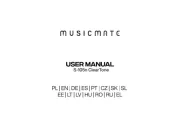
12 September 2025
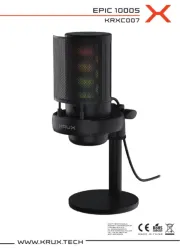
12 September 2025
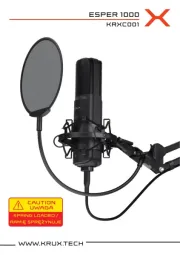
12 September 2025

12 September 2025
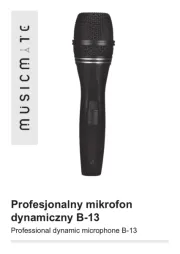
12 September 2025
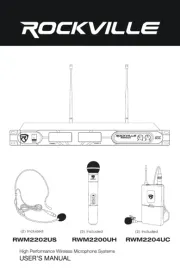
8 September 2025
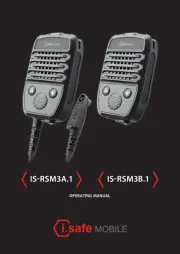
8 September 2025

8 September 2025